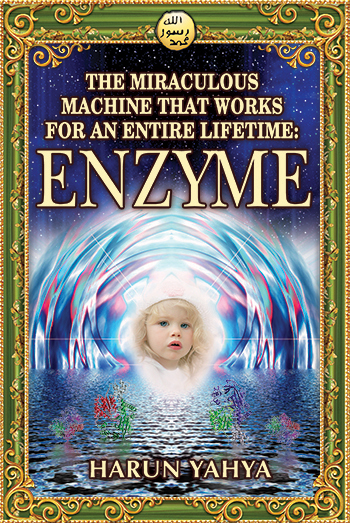Bigotry: The Dark Danger
The Miraculous Machine That Works for an Entire Lifetime: Enzyme

< <
5 / total: 7
Enzyme Technology
Many technologies have been inspired by structures in nature. Cameras and lenses have been developed by mimicking the features of the eyeball, and helicopters have been designed based on features of the dragonfly. There are many things in nature that continue to inspire technology on a chemical level. Yet there are also natural substances that we make direct use of in our daily lives. One example is enzymes. Enzymes have been prepared for us in a ready-made form in nature and are directly used in industry. The detergents we use in our homes every day are an industrial product developed as the result of the existence of enzymes. Proteases head the list of enzymes used in laundry powders. Their presence is important because, as you now know, proteases are enzymes that break down proteins during digestion. Therefore, they can easily remove protein stains—stains such as grass, blood and egg—from your clothing. The protein in these substances generally make these stains adhere tightly among clothing fibers. But these enzymes degrade the proteins causing the stain. The enzyme lipase, which breaks down fats, also works in detergents, helping dissolve fat or grease stains. Attaching to the fat molecules on clothing, they break them down and convert them into amino acid components. Enzymes are also used in the manufacture of textiles. During the weaving of cotton and cotton-mix fabrics, the long fibers that comprise the cloth are coated with an adhesive substance to prevent them from breaking during weaving. The substances employed are starch and starch by-products. Yet once the weaving has been completed, the fabric has to be freed from that starch for subsequent stages. This can be performed using such harsh chemicals as acids, alkalines and oxidants, but today this is an easy matter with enzymes. Amylase breaks down the starch without damaging the fabric. One advantage of this procedure is that it is eco-friendly. The waste water that results is less toxic. Use is also made of enzymes in improving color quality of fabric. The hairs, or fibrins, that form on the threads are broken down and minimized by enzymes. The enzyme catalase is used for fabrics that are bleached with hydrogen peroxide as pre-treatment before dying. As you'll remember, catalase is a fast-working enzyme, and so even a small amount of it is sufficient to eliminate the hydrogen peroxide. In addition, enzymes are also employed intensively in processing sugar, animal feed, and fruit juice and manufacturing paper and leather. For example, various problems arising during the production of fruit juices, particularly apple juice, can be resolved with the help of enzymes. Apple juice contains huge quantities of starch, and is cloudy in its fresh-pressed state. If transparent apple juice is desired, that starch has to be broken down—which is effected by introducing starch-dissolving enzymes. But how are enzymes obtained from the natural world? Allah has created a great means of doing so: micro-organisms. Any single micro-organism possesses more than 1,000 different kinds of enzymes—a great blessing placed at mankind's industrial disposal. Scientists collect and study different micro-organisms from different parts of the world in order to obtain different kinds of enzymes. This research continues under the microscope until they find an enzyme that performs the desired task. Then the organism that produces that enzyme is altered genetically so that it will produce larger quantities of the enzyme. Subsequently, enzymes are extracted by fermenting the micro-organism. The wastes that emerge as a result are used as fertilizer.91 In addition, enzymes can also be obtained from plants, the pancreases of large livestock, and the digestive organs of chickens and oxen. Utilizing knowledge and technology, humans have expended enormous efforts to find ways of carrying out these processes. For dissolving starch, for example, rather harsh conditions were formerly necessary. A large number of chemicals were employed, but the resulting industrial products were not wholly what was desired, and the resulting waste products were generally toxic. However, enzymes work just as if tailor-made for the task. Acting at the site, they locate the relevant starch and entirely do away with it, leaving behind the amino acids and other constituents, all of which can be safely returned to the natural environment. No human technology can endow a protein with the ability to attack a specific substance and break it down. They cannot teach it to attack a single fat molecule on a piece of cloth, nor cause it to act in a certain temperature range in such a way as to fulfill people's needs. They cannot make the resulting waste products assume a form that can be recycled and reused. Human beings cannot even produce the correct sequence of the amino acids that make up a protein. Therefore, to perform all these tasks they use ready-made natural enzymes which have been placed at mankind's disposal. The more research is performed, the more enzymes are discovered, literally gift-wrapped inside micro-organisms as major labor-saving devices, easily located where any scientist can obtain them. This blessing is bestowed by Allah. It has been given to make life easier, as a beauty and a blessing. It is Allah Who creates them in micro-organisms, Who gives them their own particular characteristics, Who permits them to be discovered, and Who gives us the ability, knowledge and means with which to study them.
Footnotes91 Bilim ve Teknik (Science and Technique), Tubitak Yayınları, October 1999, pp. 74-80
|
5 / total 7
You can read Harun Yahya's book The Miraculous Machine That Works for an Entire Lifetime: Enzyme online, share it on social networks such as Facebook and Twitter, download it to your computer, use it in your homework and theses, and publish, copy or reproduce it on your own web sites or blogs without paying any copyright fee, so long as you acknowledge this site as the reference.

